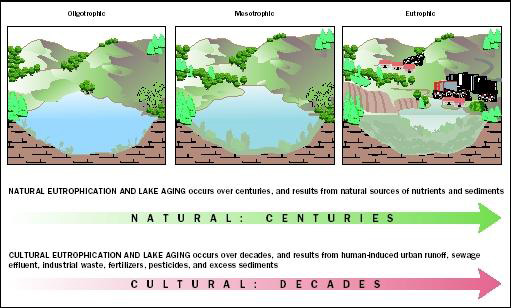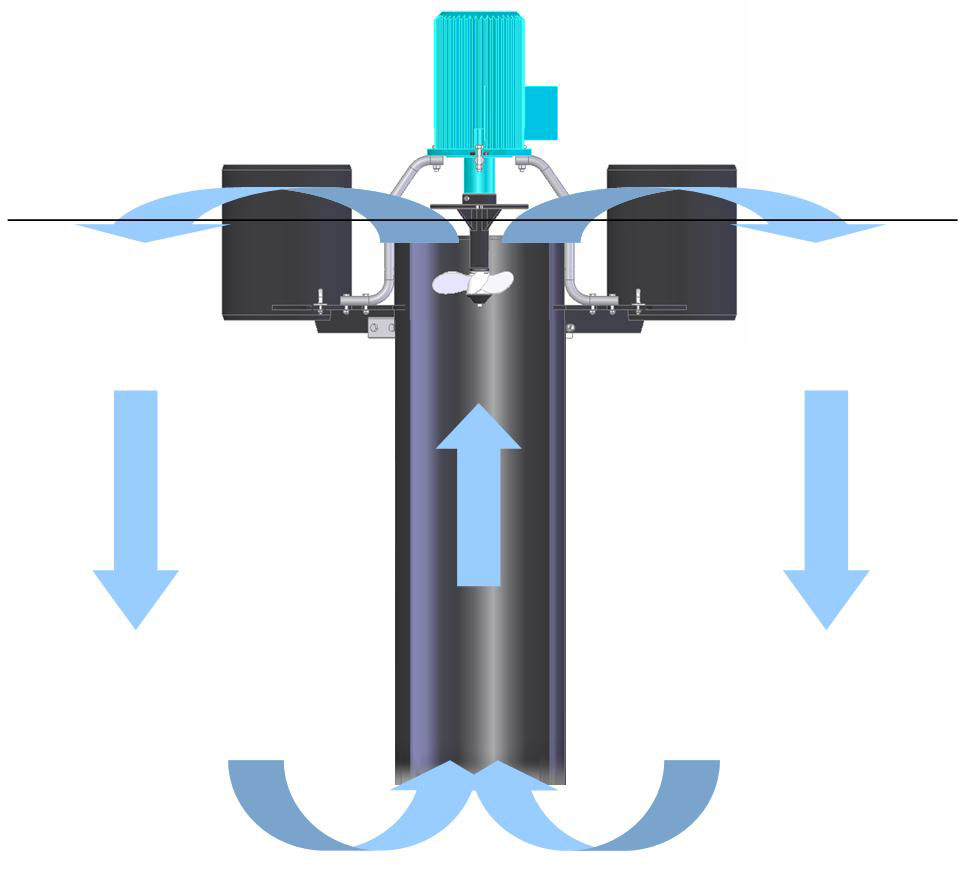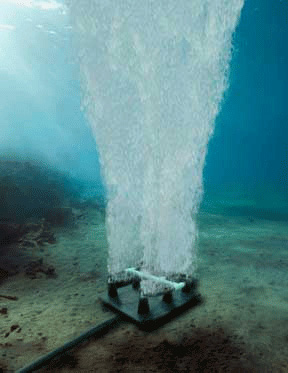November 2016–Manitowoc County Lakes Association and The Manitowoc Fish and Game Protective Association are currently working on providing aeration systems for Weyers Lake and Silver Lake.
The following summarizes some of the issues informing this effort:
 The premise that we should presume to manage a natural environment, such as a lake, still smacks of excessive hubris to many of us. But considering that left to natural ecological succession, a seepage lake will eventually disappear, and that culturally induced succession has greatly accelerated the rate of succession, we are actively managing lakes, either deliberately or by neglect. It is logical that we might at least address those counter measures which will offset the negative impacts we ourselves impose on the waters.
The premise that we should presume to manage a natural environment, such as a lake, still smacks of excessive hubris to many of us. But considering that left to natural ecological succession, a seepage lake will eventually disappear, and that culturally induced succession has greatly accelerated the rate of succession, we are actively managing lakes, either deliberately or by neglect. It is logical that we might at least address those counter measures which will offset the negative impacts we ourselves impose on the waters.
Lakes generally undergo periods of oxygen stress in at least some portion of the water column. Post bloom decay of plant material in late summer and winter ice cover can strip oxygen reserves. Human induced eutrophication negatively impacts the oxygen levels within a waterbody, and makes what might have been marginal conditions unsustainable for aquatic life. Especially over the late winter months, a lake may become oxygen depleted, with consequent fish kills.
 The fish kills are always distressing, particularly in that the mortality is generally progressive, with the fish that most of us find desirable being the most susceptible to suffocation. Even a moderate winter kill is likely to result in a preponderance of rough fish in a lake, as they handle the stress better. The ratio of predator fish to forage fish can also be disturbed, leading to gaps in the growth of a lakes population. We have long accepted that we manage fish populations through often expensive stocking programs, and the cost of managing oxygen levels must be considered as component to the fisheries management. While there are benefits aeration regarding water quality and plant growth, fishery management is demonstrably the most effective use of the systems.
The fish kills are always distressing, particularly in that the mortality is generally progressive, with the fish that most of us find desirable being the most susceptible to suffocation. Even a moderate winter kill is likely to result in a preponderance of rough fish in a lake, as they handle the stress better. The ratio of predator fish to forage fish can also be disturbed, leading to gaps in the growth of a lakes population. We have long accepted that we manage fish populations through often expensive stocking programs, and the cost of managing oxygen levels must be considered as component to the fisheries management. While there are benefits aeration regarding water quality and plant growth, fishery management is demonstrably the most effective use of the systems.
Oxygenating lakes can be effected by either active or passive means, and as always given the range of differences between lakes, the answer to which system to use is “it depends”.
Active Controls – Aeration:
The tools available to us to actively rectify low oxygen levels in lakes waters have become increasingly effective, robust, and sophisticated in recent years, impelled by the prevalence of intensively managed wastewater treatment systems. Aerators are generally diffusers, aspirators, or downflow turbines.
Diffusers:
 By far the most common installation is a compressor feeding air into a submerged diffuser. The air bubbles rise to the surface, inducing a cycling of the deeper waters to the top of the water column. As deep water is warmer, in winter this rising water will melt the surface ice, exposing the water surface to the air and effecting an oxygen exchange. Some oxygen is also absorbed from the bubbles directly into the water. If the aerator is not placed in operation before the lake becomes oxygen depleted, there is a danger that turnover in the water column will simply bring the stratified low oxygen water to the top, further depriving fish of the minimal oxygen available.
By far the most common installation is a compressor feeding air into a submerged diffuser. The air bubbles rise to the surface, inducing a cycling of the deeper waters to the top of the water column. As deep water is warmer, in winter this rising water will melt the surface ice, exposing the water surface to the air and effecting an oxygen exchange. Some oxygen is also absorbed from the bubbles directly into the water. If the aerator is not placed in operation before the lake becomes oxygen depleted, there is a danger that turnover in the water column will simply bring the stratified low oxygen water to the top, further depriving fish of the minimal oxygen available.
Diffusers come in a range of sizes, but many require very small compressors and are therefore economical in upfront and operating costs. The low energy demand has made solar powered units feasible.
Aspirators:
Aspirators float on the water’s surface, and inject surface water deeper at an angle. In doing so, they move aerated water deeper, induce mixing, and promote the ice melting water turnover.
Similar to the Aspirators, the Turbine model has a vertical pipe extending to the depths of the lake, and injects water downward.
As both Aspirators and Turbines are moving water rather than air, they require heavy duty pumps which generally require an extensive electrical supply, and often 3 phase power.
With any aeration system, protection fence on the ice around the open water is required. An alternative compliance to the law is that warning signs must be posted at all access points to the lake.
Passive Controls – Ice Management:
Although submerged life goes partially dormant in winter, both fish and plant populations continue their oxygen exchange. Winter photosynthesis will continue to oxygenate the water, albeit at a reduced rate. In low nutrient lakes, rooted plants remain functional as oxygen generators, in Manitowoc’s nutrient laden lakes, most wintertime photosynthesis occurs through algae, according to Paul Skawinski of UW Stevens Point. John Greenbank, in his paper “Limnological conditions in ice covered lakes” concludes: “It has been pointed out that there is a definite relationship between the amount of light penetrating the snow and the ice cover and the dissolved oxygen content of the water. The presence or absence of a long continued snow cover can mean the difference between safety and doom for the fish. It is therefore apparent, and has been mentioned by several authors, that by far the best single method of preventing winter-kill, from a theoretical viewpoint, is the removal of snow from the ice.”
As plant life in our lakes is generally limited to shallow waters, it is only effective to clear those areas of the ice, minimizing costs. Ken Schuler at Cedar Lake plows a skating track at that lake’s periphery, which exemplifies a means of creating higher value to the oxygenating effort. Skating rinks, etc. could also be maintained to dual effect.
Simply flooding the ice surface with a small submersible pump would render reflective snow into a transmitting ice slush, and would not require plowing.
Both active and passive strategies would benefit from experimental observation and analysis to determine empirical results and optimized methodologies.


